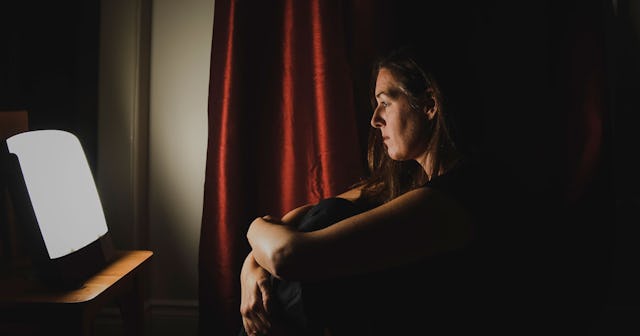Seasonal Affective Disorder Isn’t Just A Winter Thing

The birds are chirping. The sun is shining. The weather is warm. From beach days and play dates to late nights and trips to the pool, summer is supposed to be fun. But what happens when it isn’t? What happens when the dog days turn out to be a real drag?
Turns out your mood changes may actually be a psychological response to the seasonal shift: You may actually be suffering from a condition known as SAD, or seasonal affective disorder.
“Seasonal affective disorder (SAD) is a type of depression that’s related to changes in seasons,” an article on the Mayo Clinic explains. “SAD begins and ends at about the same times every year…. and [while] in most cases, seasonal affective disorder symptoms appear during late fall or early winter and go away during the sunnier days of spring and summer. [Some] people experience the opposite pattern. [They] have symptoms that begin in spring or summer.”
Here’s everything you need to know about SAD, or summer depression.
What is seasonal depression?
As noted above, seasonal depression — or seasonal affective disorder — is a condition which occurs during the change in seasons. It affects about 4% to 6% of the U.S. population and typically appears when the days get shorter and colder. However, about 10% of people get SAD symptoms during the summer season.
Why do seasonal changes cause depression?
While the specific cause of seasonal affective disorder is unclear, it is believed numerous factors can contribute to this condition, including a drop in melatonin and/or serotonin levels or a change to your body’s circadian rhythm. “The reduced level of sunlight in fall and winter may cause winter-onset SAD,” an article on the Mayo Clinic explains. Summer-onset SAD, however, is likely caused by the increased length of the day[s] and rising levels of heat and humidity.
That said, it is worth noting that all of these causes are hypothetical. A single source is not none.
What are the symptoms?
According to the Mayo Clinic, the symptoms of SAD — or seasonal depression — are similar to that of major depressive disorder and include the following:
- Feelings of depression that happen daily or near-daily
- A loss of interest in once-enjoyable activities
- Low energy or problems/changes in sleeping patterns
- Changes in your weight or eating habits
- Trouble concentrating
- Feelings of hopelessness or guilt
- Thoughts of suicide
Emotional numbness can also occur.
Who gets seasonal depression?
While seasonal depression affects millions, certain people are more likely to have SAD than others, including:
- Women. Females are more affected by major depressive disorder (or MDD) with a seasonal pattern than males, though men typically report more severe symptoms.
- Those who are genetically predisposed to depression and/or another mental health condition. Having a relative with depression, anxiety, bipolar disorder, or another mood disorder increases your risk.
- Those who live close to the equator. While it is not known why, a dated but still relevant study found that people in hotter areas have more summer-induced depression than those living in cooler areas.
Individuals with bipolar disorder may also see seasonal flareups.
How is SAD diagnosed?
It can be hard to diagnose seasonal affective disorder, or SAD, in patients because it mirrors the symptoms of major depressive disorder so closely. However, your doctor may use several tools to better understand your condition, i.e. they may conduct a physical exam, do blood work, or run lab tests. A complete psychological examination will also occur, and understanding the timing of your depression is integral.
“The main feature of SAD is that your mood and behavior shift along with the calendar,” an article on WebMD explains. “You may have SAD if, for the past 2 years, you had depression or mania that starts as well as ends during a specific season… [and] didn’t feel these symptoms during your ‘normal’ seasons.”
How can seasonal depression be treated?
“Treatments differ, depending on how severe your symptoms are,” an article on WebMD explains. What’s more, “the type of treatment you get also depends on whether you have another type of depression or bipolar disorder. [However,] traditional antidepressants are often used to treat seasonal depression. Bupropion XL is currently the only medication that is FDA-approved specifically to prevent major depressive episodes in people with SAD.”
Light therapy is also regularly used, though the effectiveness of light therapy in the summer months is unclear.
While seasonal depression can feel overwhelming, the good news is that this wave — like most depressive episodes — will pass. You just have to “ride it out.” However, you do not have to do so alone. There is help and hope.
This article was originally published on